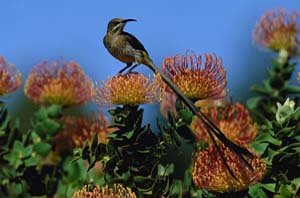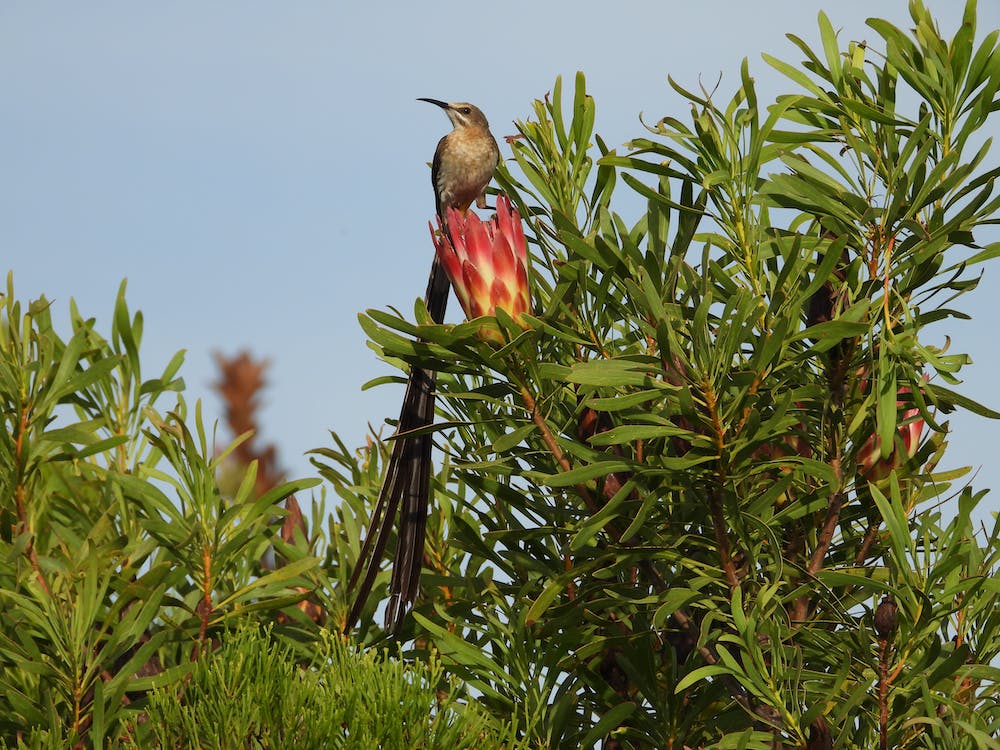The Cape Sugarbird, also known as the Promerops cafer, is a beautiful bird that is indigenous to South Africa. It is a noisy, conspicuous bird that is considered a vital pollinator of various plants. The Cape Sugarbird is regarded as one of the eight birds that are commonly found in the Fynbos biome of Eastern Cape and Western Cape of South Africa.
This bird species is under the Promeropidae family, which is a group of passerine birds that are only endemic to the southern African region. They are long-tailed little birds that are possible closely related to Australian honeyeaters. The Cape Sugarbird’s close relative is the Gurney’s Sugarbird, a bird that is endemic to Zimbabwe and other southern African countries.
The bird species was first described in 1758 by Swedish botanist, zoologist, and physician Carl Linnaeus, who is honored as the father of modern taxonomy. The binomial name “cafer” is a Modern Latin version of the word “caffer,” which means South Africa (Caffraria) or South African.
Since the Cape Sugarbird’s population appears to be on a continuous rise, the International Union for Conservation of Nature categorized this bird species as Least Concern.
Its seven levels of scientific classification are as follows:
Kingdom: Animalia
Phylum: Chordata
Class: Aves
Order: Passeriformes
Family: Promeropidae
Genus: Promerops
Species: P. cafer
The physical characteristics of a Cape Sugarbird
The Cape Sugarbird is a medium-sized passerine that weighs between 26 and 46 g. A male Cape Sugarbird is 34-44 cm long, while a female Cape Sugarbird is 25-29 cm long. It has a grey-brown plumage, making it pronounced and easily recognizable due to the yellow spot located under its tail. Both male and female Cape Sugarbirds have elongated tails, but the male’s tail is more massive. A female Cape Sugarbird has a shorter bill, tail, and a paler breast.
Both male and female Cape Sugarbirds have long, slender, and slightly curved bills, but the female’s bill is somewhat shorter. The disparity between the bills leads to differences in feeding niches and techniques. The skull and tongue morphologies are similar to honeyeaters.
The distribution and habitat of Cape Sugarbirds
Cape Sugarbirds are widely dispersed across the Fynbos in South Africa. This habitat is a vegetation type of the Western Cape Province and Cape Floral Region, where flowering proteas and ericas thrive. The Cape Floral Region is also an area that has not been burnt.
Cape Sugarbirds are also sighted in suburban gardens during summer and enclose fynbos isolates.
The behavior of a Cape Sugarbird
A Cape Sugarbird needs nectar from the inflorescences of the Protea to survive, as nectars provide the energy they need to function. It sings a distinct chipping, grating, and twanging song.
Cape Sugarbirds commonly form small groups or pairs, with males usually seen sitting prominently atop a large protea bush. These birds are monogamous—they form bonds that last a lifetime. A male Cape Sugarbird is a solitary nester—it defends his territory from foreign intruders.
The breeding season of the birds takes place from February to August, during winter, in South Africa. On the other hand, breeding season dawns from April to September in south-western Cape Province. This schedule coincides with the flowering season of proteas. During this period, male Cape Sugarbirds mark their territories by performing loud vocal displays.
A pair of Cape Sugarbirds will form an untidy cup-like nest using grassroots, twigs, and pine needles. This nest is placed in tangled branches of a protea bush or trees with large leaves.
A female Cape Sugarbird usually lays one to two eggs, all of which will be incubated by the female alone for 12 to 21 days. Once the eggs are hatched, the chicks will be fed by the parents. They will start to fledge 18 days after they were hatched. Young will become independent three weeks after they fully fledge. The Cape Sugarbird’s life expectancy is estimated at seven years.
The diet of Cape Sugarbirds
As was mentioned before, this bird species is a widespread nectar feeder. Its sharp, long beak can reach the nectar of different proteas using its brush-tipped tongue. This feeding technique makes the Cape Sugarbirds an effective pollinator of various plants. Likewise, Cape Sugarbirds also feed on a wide range of insects such as flies, beetles, aphids, grasshoppers, spiders, and many more.
BOTSWANA BIRDS | SOUTH AFRICA BIRDS
NAMIBIA BIRDS | ZAMBIA BIRDS | ZIMBABWE BIRDS


